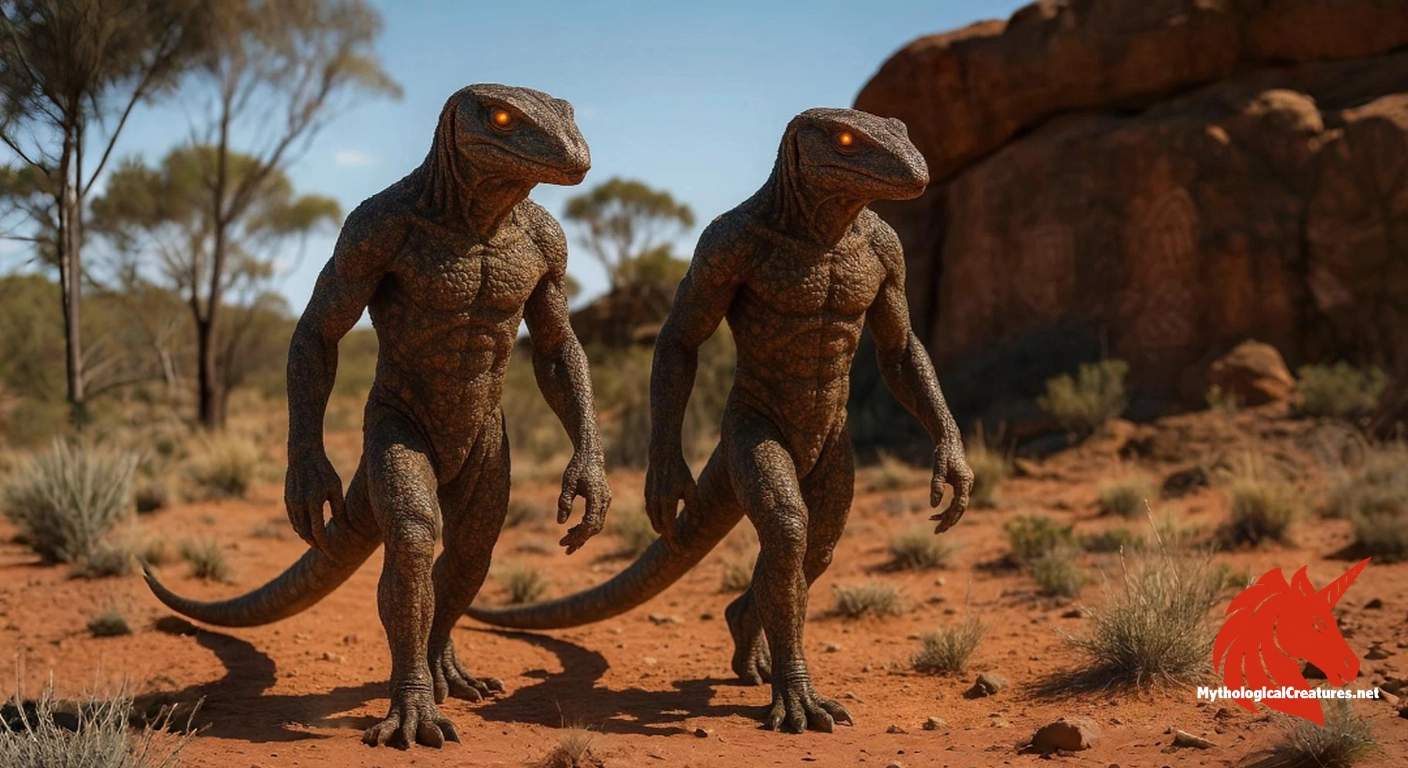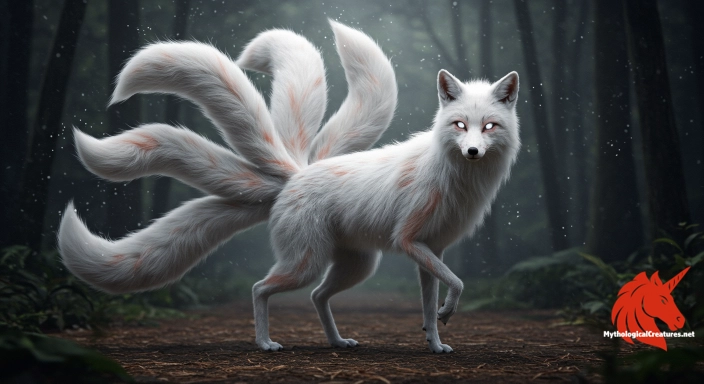Wati-kutjara: The Wati-kutjara are two young lizard-men central to Western Desert Aboriginal Dreaming, whose journey spans thousands of kilometres across Australia.

Wati-kutjara
Wati-kutjara - They exemplify the enduring legacy of the Dreamtime, influencing art, culture, and spirituality.
Origins & First Encounters
The Wati-kutjara are celebrated figures within Western Desert Aboriginal mythology, embodying the vibrant spirit and creative energy of the Dreaming. Their narrative centres on a pair of young lizard-men whose journeys have long been woven into the fabric of indigenous cultural identity. Emerging from ancient oral traditions, they represent both the dynamism of youth and the enduring wisdom of ancestral beings. Their extensive travels across the harsh yet beautiful desert landscape stand as a testament to the importance of movement and connection within these communities. The dual figures are believed to have imprinted songlines, which continue to guide cultural ceremonies and the mapping of sacred sites. Their origin is enshrined in a time when the land itself was shaped by powerful spiritual forces, making them central to the oral histories of many clans. As symbols of renewal and transformation, they encapsulate complex ideas of creation, law, and the natural order. The stories of the Wati-kutjara are not only a record of ancient cosmology but also a living tradition that unites people with the rhythms of the earth. This enduring myth continues to influence contemporary practices and beliefs, underscoring the deep connection between the people and their landscape.
Source Texts & Tale Variants
The lore of the Wati-kutjara has been transmitted through generations via rich oral traditions, ensuring that their story remains vibrant in the cultural consciousness of Aboriginal peoples. Narratives passed down from elders provide a variety of accounts that reveal different facets of their character and journey. Elements of their story have been captured in rock art and ceremonial songs that serve as both historical documents and living expressions of identity. Early ethnographic studies and recordings of Dreaming stories contributed valuable insights into their role within the mythology of the Western Desert. Each version of the tale emphasises distinct qualities—some portray them as playful tricksters while others focus on their solemn responsibility as custodians of creation. Local storytellers often adapt the narrative to reflect seasonal changes and geographical nuances, resulting in a multitude of interpretations. The interplay between documented records and oral traditions illustrates how fluid and adaptive cultural narratives can be. Ongoing fieldwork and collaborations with indigenous communities have enriched our understanding by situating these stories within a broader context of land and law. In this way, the story of the Wati-kutjara is continually reaffirmed and reimagined, bridging the past and the present.
Form & Powers
Depictions of the Wati-kutjara vividly capture a fusion of human attributes with the distinctive features of the goanna, their totemic animal. They are often illustrated with a lithe, sinuous physique that mirrors the agile movements of a lizard, complete with intricately patterned scales that echo the colours of the desert landscape. Their limbs are portrayed as both strong and graceful, suggesting a balance between power and delicate movement. Artistic renditions frequently highlight large, expressive eyes that seem to convey a deep connection with the land and its myriad mysteries. The figures are sometimes shown with elongated tails that serve as extensions of their narrative, twisting and turning to symbolise the meandering course of the Dreaming. Their skin tones, rendered in warm earthy hues, reflect the sun-baked colours of rock faces and desert sands. In some interpretations, the lizard-men are adorned with ceremonial markings that enhance their mythic presence, visually linking them to ancestral beings. Variations in size and posture across different artworks underline both the symbolic diversity and the unifying themes of youthful energy and ancient wisdom. Through each detailed illustration, the physicality of the Wati-kutjara becomes a powerful expression of the intimate bond between nature, art, and spirituality.
Regional Faces
Regional interpretations of the Wati-kutjara reveal a fascinating diversity in how their mythology is interwoven with local landscapes and cultural practices. In the remote areas of the Kimberley, narratives often portray them as architects of the natural world, their feet leaving impressions that later become significant landmarks. Communities further south integrate the tale with seasonal cycles, attributing changes in the environment to the movements of these mythical beings. Variations in the story reflect subtle differences in language, song, and ceremonial art, illustrating how local traditions adapt a common myth to unique geographical and cultural contexts. In some regions, the Wati-kutjara are revered as both creators and protectors, with their journeys marking the establishment of water sources and other vital features of the desert. Local artisans and storytellers modify details to resonate with specific rituals, infusing the myth with a distinctly regional flavour. The adaptability of their narrative highlights an enduring flexibility that allows each community to connect the tale with its own lived experience. Despite these regional differences, a shared reverence remains at the heart of all interpretations, as each tradition honours the lizard-men’s profound influence on the land and its people. In this way, the myth transcends regional boundaries while celebrating diverse expressions of cultural identity.
Cultural Parallels
The tale of the Wati-kutjara resonates with themes common to many indigenous mythologies that celebrate dual figures and transformative journeys. Their narrative shares similarities with other foundational myths, such as the Rainbow Serpent, which also links the physical landscape with spiritual creation. Like many pairs of cultural heroes found in mythologies around the world, the two lizard-men represent a duality—embodying both the vitality of youth and the revered wisdom of tradition. This interplay of opposites is a recurrent motif that underscores the universal human endeavour to explain the origins and workings of the natural world. Comparative analysis reveals that their journey across vast terrains mirrors the hero’s journey archetype, a pattern found in diverse religious and mythological landscapes. In some South American and African traditions, dual deities navigate the worlds of both nature and humanity, serving as mediators between mortal life and cosmic forces. The parallel roles they play as both guides and creators invite a broader reflection on how cultures use myth to bridge existential gaps. Examining these cross-cultural connections enhances our appreciation of the symbolic power embedded in dual mythic figures. In essence, the Wati-kutjara provide a rich tapestry of meaning that speaks to the collective human experience, transcending geographical and cultural boundaries.
Legacy & Modern Evolution
The legacy of the Wati-kutjara has evolved over centuries, adapting to changes in cultural practice while remaining a cornerstone of Aboriginal mythology. Their myth has been revitalised in modern artistic movements, where traditional motifs blend with contemporary interpretations in paintings, sculptures, and dance. This evolution reflects a cultural renaissance, as indigenous communities reclaim and reinterpret their heritage through multiple media. The lizard-men, once only figures of oral tradition, now inspire digital art, literature, and educational programmes that aim to preserve the wisdom of the Dreaming. Their enduring presence in modern cultural discourse is a testament to the resilience of Aboriginal identity and the power of myth to adapt over time. As society becomes increasingly interconnected, the story of the Wati-kutjara continues to serve as a symbol of environmental stewardship and communal belonging. Their narrative plays a vital role in cultural celebrations and is frequently invoked to promote reconciliation and the revitalisation of native customs. In many ways, the modern legacy of these figures is inseparable from a broader movement to acknowledge and celebrate the depth of indigenous knowledge. The ongoing dialogue between tradition and modernity ensures that the Wati-kutjara remain both timeless and ever-relevant in a rapidly changing world.
Interesting Fact
Their songline, known as the Two Men Dreaming, continues to inspire contemporary Aboriginal art and storytelling, forging an unbreakable link between ancestral traditions and modern cultural identity.
Quick Creature Info
Origin:
Associations:
Our Mythic Legendary Rating:

Also Sometimes Known As:
Habitat:
Supernatural Powers:
Physical Attributes:
Abilities:
Behavior:
Lore:
Related Creatures, Tales or Lore
- RRainbow Serpent
- NNaga
- YYurlunggur
References
Discover Another Mythical Legend You May Not Have Heard Of?
Uncover the mysteries of ancient folklore and expand your knowledge of legendary beings from cultures around the world.
Dare to Meet the Kuzunoha....
Mythical Disclaimer: The images and data on this site are derived from various historical and literary sources, but we have found that many myths often have multiple versions and interpretations across references, sometimes contradictory. As a result, these creature depictions are artistic interpretations—imaginative blends of folklore, legend, and a dash of AI guesswork. Because creature descriptions vary widely, our illustrations and accompanying information represent our best effort to honor mythology while bridging creative gaps. Enjoy these interpretations—just remember, we've done our best to respect the stories and validate available data, but in the realm of mythology, details often shift, imagination leads the way, and nothing is ever set in stone!
Curated by the Mythological Creatures Team (rev. May 2025)
